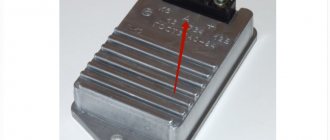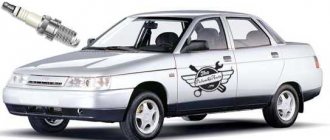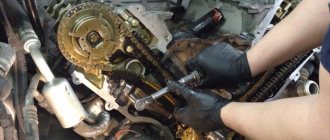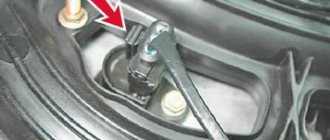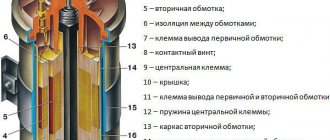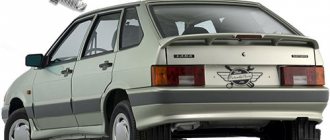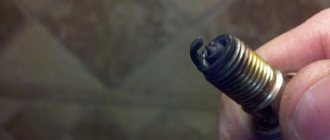1. When trying to start the engine, the crankshaft does not rotate
1. The terminals on the battery terminals are not tightened enough or are oxidized.
2. The battery is low or faulty.
3. The starter electrical circuit is faulty ("Starter"),
4. Starter drive parts are faulty.
5. The starter traction relay is faulty.
6. The electric motor (armature, brush assembly windings) of the starter is faulty.
7. The ignition switch (lock) is faulty (see “Ignition switch (lock) - check”)
8. The flywheel ring gear is damaged or worn.
2. The crankshaft rotates, but the engine does not start
1. There is no fuel in the tank (fill the tank with fuel).
2. The crankshaft does not rotate fast enough to start the engine due to the low battery charge.
3. The terminals on the battery terminals are not tightened enough or are oxidized.
4. Leakage of parts of the power system, faulty fuel module or fuel pressure regulator.
5. The timing belt is broken.
6. The engine control system is faulty.
7. The electrical circuit of the ignition coils is faulty.
8. The crankshaft position sensor or its electrical circuit is faulty.
3. Difficulty starting a cold engine
1. The battery is discharged or the electrolyte level is insufficient.
2. The power system is faulty.
3. The engine management system coolant temperature sensor is faulty.
4. Fuel injectors are leaking.
5. The engine control system is faulty.
4. It is difficult to start a warm engine
1. The air filter is clogged.
2. The power system is faulty.
3. The terminals on the battery terminals are not tightened enough or oxidized, the connection between the battery and ground is poor.
4. The engine management system coolant temperature sensor is faulty.
5. The starter makes a lot of noise (grinding)
1. The flywheel ring gear is damaged or worn.
2. The starter mounting bolts are loose.
6. Engine starts but stops immediately
1. Ignition coil electrical connections are loose or damaged.
2. Insufficient pressure in the engine power supply system.
3. The connections of the intake tract parts are leaky.
4. The engine control system is faulty.
7. Oil stains appear under the engine
1. The oil pan gasket is leaking or the drain plug is not tightened tightly.
2. The seal of the emergency oil pressure sensor is broken.
3. The cylinder head cover seal is leaking.
4. Crankshaft seals are worn or damaged.
8. Engine speed at idle either decreases or increases
1. The connections of the vacuum hoses are leaking (check the tightness of the fittings).
2. The air filter is clogged.
3. Insufficient fuel pressure in the engine power supply system.
4. The cylinder head gasket is damaged.
5. Wear of the timing belt and/or tension roller.
6. Worn camshaft cams.
9. Misfire at idle
1. The spark plugs are faulty or the gap between the electrodes is incorrectly set.
2. High voltage wires are faulty.
3. The connections of the vacuum hoses are leaking (check the tightness of the fittings).
4. The ignition coil is faulty.
5. Insufficient compression in the engine cylinders.
6. Fuel injectors are faulty.
10. Misfire when the engine is running under load (while the car is moving)
1. The fuel filter and/or the engine power supply lines are clogged.
2. Fuel injectors are faulty.
3. The spark plugs are faulty or the gap between the electrodes is incorrectly set.
4. The insulation of high-voltage wires is damaged.
5. The engine control system is faulty.
6. Insufficient compression in the engine cylinders.
7. Leakage (burnout) of the gas distribution mechanism valves.
Check if the winding is shorted to ground
This diagnostic stage is done quite simply and will not take much time. The main thing is to connect everything correctly.
- First, we set the position of the pointer of the device for measuring resistance; I think there is no need to explain this in detail.
- Then you need to connect one contact terminal of the device to the central contact on the coil, and connect the second to ground. If you explained something incomprehensibly, then you can see how it all should look visually in practice. The photo below shows everything perfectly.
How to check the ignition coil on a Priora
One of the main signs of a malfunction in the Priora IKZ is engine tripping. Since the coils on the Priora are individual, only one cylinder will not work, that is, signs of tripping will appear on the power unit. This, of course, is not a 100% diagnosis, but there is quite enough reason for the Priora ignition coil to be checked.
Checking the ignition coil with a multimeter
To remove the ignition coil you must:
- prepare a socket wrench set to “10”;
- disconnect the battery;
- remove the casing covering the engine;
- press the plastic clamp and disconnect the block with wires from the coil terminal;
- Unscrew the short-circuit fastening bolt with a “10” key;
- pull out the short circuit from the spark plug hole.
After the coil is removed, it is necessary to carry out an external inspection. There should be no microcracks, melting or drips on the rubber cap and body. Only slight smoking is possible. Checking the electrical part is possible in several ways.
- Complete with a working spark plug, check the device for a “spark” against the car body. If there is no spark, then it is very likely that the short circuit has failed. In this case, it is advisable to check the gap in the spark plugs; the Priora may become unstable while driving.
When checking a short circuit for a spark, you must work with rubber gloves and take special care to avoid contact with your body or other tool with the body of the machine or engine. The coil produces a high voltage current from 20 to 40 kW.
- You can put the removed coil on a working cylinder of another car and check it in motion. A faulty short circuit will immediately manifest itself.
- Check the short circuit using an instrumental method.
The main enemies of the ignition coil are high temperature or overheating, due to which microcracks form on the cap and body, as well as corrosion, that is, moisture; in addition, frequent turning on of the ignition switch without starting the engine and prolonged load during unsuccessful starting have a bad effect on the condition of the short circuit.
Automotive electricians recommend frequently cleaning the short-circuit fastening points from dust and moisture, checking the tightness of all wires, especially high-voltage ones, and also changing the short-circuit after the warranty period has expired, regardless of whether they show signs of malfunction or not.
Misfires - causes, diagnosis, elimination
Do you experience misfires at idle or under load? Misfire is one of the most common problems when it comes to modern gasoline engines. The spark is critical to the operation of the engine.
There are many reasons that can cause a misfire. They are not easy to eliminate, especially if you don’t know where to look for them.
In this guide, we'll look at the symptoms of misfires, their causes, and how to best troubleshoot them.
What is a misfire?
To know what a skip actually is, we first have to start with the basics of how a car engine works.
Here you can see a good illustration of how the pistons and crankshaft move inside the cylinder when the engine is running. The pistons are pushed down by an explosion inside the cylinder. The piston, moving down, rotates the crankshaft. The operation of an engine can be divided into four stages, which is why this type of engine is called a four-stroke engine.
- The piston moves down, filling the cylinder with the air-fuel mixture from the intake.
- The piston goes up, compressing the air-fuel mixture to high pressure.
- A spark from the spark plug ignites the air-fuel mixture and the explosion pushes the piston down, rotating the crankshaft.
- The piston rises up, squeezing the burnt air-fuel mixture through the outlet.
- Repeat the process from step 1.
This is a description of the operation of a four-stroke engine, which is installed in almost all modern cars. There are some older cars that use a 2-stroke engine, but we won't cover them.
A misfire occurs when one or more of these steps are incorrect or missing.
- The air/fuel mixture is too lean or too rich.
- Bad ignition spark, incorrect ignition timing.
- Low compression, accounting for the air-fuel mixture.
- Incorrect timing of intake or release of the air-fuel mixture.
Now you know the basics of how a cylinder works in a car engine and at what stages misfire can occur. With this knowledge it is much easier to find the reason why misfire occurs.
As you can see, in theory there are not many reasons. But when you start diagnosing your car, you'll realize that it's not always that easy to find the problem. Let's continue to learn how to diagnose and how to fix misfires at home.
Signs of misfire
There are several different symptoms that you may experience when it comes to engine misfire. Here are some of the most common ones.
Uneven acceleration
When a misfire occurs, you may feel it as a slight or strong jolt coming from the engine. These misfires often occur while the engine is running under load and you are accelerating at high RPMs and high gears. Acceleration problems are a common sign that your engine is misfiring.
Unstable idle
Sometimes there will be passes at idle. The engine sensors receive incorrect readings and the air/fuel mixture becomes incorrect. This can result in a very rough idle. The revolutions can jump up and down, until the engine stops.
Vibrations
The car engine is balanced at the factory using various balancers to get as little vibration as possible from it. When one cylinder is not firing properly, the engine becomes unbalanced and this can cause severe vibrations in the cabin during acceleration or idling.
Check Engine light on
Modern cars monitor the status of all engine sensors. If the sensor fails or it senses that something is wrong with the engine, it will send information to the control unit. When the ECU receives the data, it will decide whether the problem is serious or not. If the problem occurs repeatedly, the control unit will turn on the Check Engine Light so you can take action.
Slow acceleration
As we said earlier, skipping can cause the oxygen sensors to receive erroneous information and create a mixture that is too rich or too lean.
A mixture that is too lean or too rich can cause sluggish acceleration and even put your car into protective mode. This will cause the engine to not spin above 3500 rpm and the ECU will turn off the turbo.
Changing the engine sound
If you know a little about cars, you will have noticed that there is a difference in the sound of different engines. V8 engines have a very different tone than a four-cylinder engine.
If your 4 cylinder engine is misfiring in one cylinder, it may sound like a 3 cylinder. If your car sounds unusual, it's most likely misfiring.
Causes of misfires
Now that you suspect a misfire, where should you start looking for the problem? Here are the most common reasons for absences, ranked from most common to least common.
Faulty ignition coil or distributor-breaker (distributor)
If you have an older car, this is the most common reason. Some vehicles have a separate ignition coil for each plug, while others have a single coil with ignition cable for each plug.
Older cars have a breaker and in some cases also an ignition coil. If you have separate coils, then disconnect each one to find out which cylinder is misfiring. Replace the faulty ignition coil.
Faulty spark plugs
The second most common cause of misfires is bad spark plugs. Spark plugs ignite the mixture in the cylinders, and they wear out over time. Spark plugs are inexpensive and easy to replace. If you can't remember the last time you changed your spark plugs, it might be time for it.
Intake manifold leaking
Leaks near cylinder heads are also very common when it comes to spark plugs. This problem was common in older cars without steel intake manifold gaskets.
If you have an old engine, you can check this. If you have a new car, check for other signs of leaks around the intake manifold gasket. Check for damaged vacuum hoses.
Low fuel pressure
May be caused by a faulty fuel pressure regulator, faulty fuel pump, or clogged fuel filter. Low fuel pressure will cause the engine to lean, causing misfire in all cylinders. If you have ignition fault codes on all cylinders, check the fuel pressure.
Injectors
Another problem that used to be common was problems with injectors. A faulty fuel injector can cause a misfire.
This is quite difficult to diagnose without checking the injector operation. Injector problems are not common on new cars, so check for other possible causes first.
Low compression/damage inside the engine
If you've checked everything else, you may have low compression or damage inside the engine. A worn timing belt can also cause low compression - check this first.
Is it safe to drive with a misfire?
If a leak occurs, the air-fuel mixture entering the engine will come out unburnt. Modern cars have a catalytic converter that reduces emissions from the car. The catalyst during operation can have a temperature of up to 600 degrees.
And what happens when the unburnt air-fuel mixture gets into it? That's right, it will explode inside the catalyst. Explosions inside the catalytic converter can damage it. And a new catalyst is not a cheap pleasure.
In addition, misfires can also damage other sensors in the engine, such as oxygen sensors. We would never recommend driving a vehicle with a misfire, especially over long distances. Short distances to a service station without stress on the engine are normal, but don't ignore gaps and continue driving.
How does the ECU know when misfires occur?
The ECM may detect misfires differently depending on the vehicle model and engine. The ECU uses many sensors to know when to fire the spark plug, when to inject fuel into the cylinder, and how to change the air-fuel mixture. To detect misfires, the control unit often uses a crankshaft sensor.
Engine ECU
The crankshaft sensor measures the position of the crankshaft and calculates its revolutions per minute. The crankshaft sensor uses the camshaft sensor to determine which cylinder is at top dead center and ready to ignite.
Pushing the pistons down causes a slight increase in crankshaft speed. If the crankshaft sensor does not recognize this increase in speed, the engine control unit will store a fault code on the cylinder on which the misfire occurred.
Sometimes the control unit cannot determine which cylinder is misfiring and it stores the error code P0300 (random misfire).
Some ECUs use ignition coil resistance. When ignition does not occur, the control unit understands this through the electrical wiring, which leads to an error. This method is not as common as detection using the crankshaft sensor.
How to diagnose and fix omissions
If you read the article from the beginning, you now know what can cause gaps. If you came straight to this point, then we will briefly write down the possible reasons for you. Omissions occur when one of the following is missing or occurs at the wrong time:
- Ignition.
- Fuel-air mixture.
- Compression.
To diagnose omissions, we must check everything. But some mistakes are more common than others. Starting in the right direction can save you a lot of time. Let's write a short guide on what to do when trying to find the cause of a misfire.
Reading errors
The first thing to do is read the errors from the ECU. You can do this yourself using an OBD2 scanner and the Torque or ScanMaster program.
For budget models, we can recommend Scan Tool Pro Black Edition . The advantages of this brand include diagnostics of not only the engine, but also other vehicle systems. The scanner is also compatible with 99% of cars produced in 1993, is quite easy to use and has wide functionality.
If you find errors in the controller code memory, write them down and erase them. We will need them in the next step.
Now that you know the error code, you need to understand what it says. Further diagnosis depends on this.
Case 1: You have counted many misfire error codes on different cylinders. Additionally, there are errors related to the air-fuel mixture
For example. If you have two or more of these trouble codes:
In this case, if the engine is running rough or unstable, you should start repairs with the air-fuel mixture. Most likely problems with it are caused by omissions. If you have looked for a code related to the air/fuel mixture along with a skip code, always start your search with the mixture. There are times when mixture errors occur due to omissions, but this happens rarely.
Common causes should be checked. Start with air leaks around the intake manifold and check the hoses for cracks. You can use brake cleaner or "quick start" spray to gently spray around the intake while the engine is idling. If the rpm goes up, there is an air leak. Remember that these sprays burn very easily, so have a fire extinguisher ready just in case.
If there are no intake leaks, the next step is to look into the trouble code related to the air-fuel mixture. You can use Google to find the possible causes of this fault code and how to resolve it.
Case 2: You read a fault code on a specific cylinder again and again despite erasing it
If you're getting an error on a specific cylinder all the time, or just misfire errors with no other associated trouble code, just read on. This problem is much easier to solve. We'll cover this in the next step.
